Degas Put to the Test:
Is He or Isn’t He?
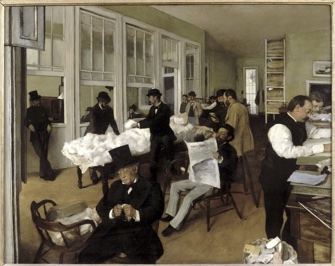
“Portraits dans un Bureau (Nouvelle-Orléans)” (1873) © RMN-Grand Palais/Photos: Michèle Bellot and Madeleine Coursaget
The exhibition’s title says it all: “Degas: An Impressionist Painter?” The Musée des Impressionismes Giverny has set out to answer a question that was already being posed in the 1870s, and while it doesn’t provide a definitive yes or no answer – “Degas is hard to pin down,” says Xavier Rey of the Musée d’Orsay, co-curator of the exhibition with Marina Ferretti – it does a delightful job of exploring the question.
Edgar Degas (1834-1917) has generally been thought of as Impressionist painter, but while he did help organize and promote Impressionist exhibitions and even showed in them, he disliked the term and scorned Impressionist habits like painting landscapes en plein air. He supposedly said to art dealer Ambroise Vollard: “If I were the government, I would have a special brigade of gendarmes to keep an eye on people who paint landscapes from nature.”
The participation in the exhibition of the Musée d’Orsay, which owns a large collection of works by Degas (and provides a de facto answer to the question posed by this exhibition by presenting his works in the same rooms as Monet and other Impressionists), ensures that the Giverny show includes sterling works by the 19th-century painter famed for his
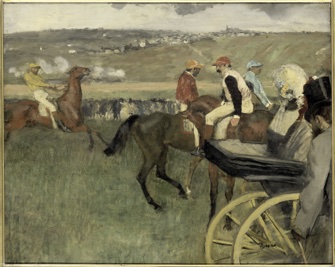
“Le Champ de Courses, Jockeys Amateurs près d’une Voiture” (1876-87 © RMN-Grand Palais (musée d’Orsay/Photo: Hervé Lewandowski
in-depth studies of ballet dancers and horses in movement but whose work went far beyond to encompass many other subjects. Degas preferred to paint figures and did his painting in the studio. He did not avoid landscapes entirely, however, and this exhibition includes
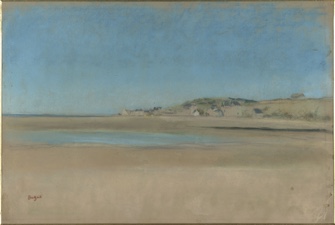
Maisons au Bord de la Mer“ (c. 1869, détail). © RMN-Grand Palais (Musée d’Orsay)/Photo: Hervé Lewandowski
a number of lovely pastel landscapes, seascapes and even a view of the smoking Mount Vesuvius. As Rey points out, however, these were more like “memories of landscapes,” painted in the studio. A couple of oil paintings of villages, such as “Vue de Saint-Valéry-sur-Somme” (1896-98) clearly show the influence of Cézanne.
Like his contemporary Manet, Degas was a great innovator, in the avant-garde of his time, painting scenes from unusual perspectives and framing them in offbeat ways, as in the view of the stage from above in “Ballet” (c. 1876), in
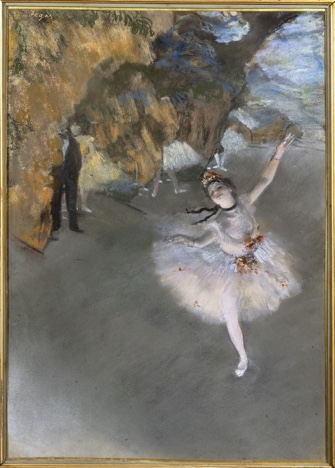
“Ballet” (c. 1876). © Paris, Musée d’Orsay, Dist. RMN-Grand Palais/Photo: Patrice Schmidt
which the ballerina appears to be on the verge of flying off the canvas into space. His great modernity foreshadows the work of Picasso, says Rey, who notes that Degas was also a great illustrator and a classically trained artist influenced more by the Renaissance than the classical period.
The range of works shown here is impressive, from the almost photographic “A Cotton Office in New Orleans” (1873; pictured at top of page) – what could be further from Impressionism? – to the softer and very charming “Women Ironing” (c. 1884-86), in which one woman yawns lustily while the other puts her back into her arduous task.
Toward the end of his life, Degas’ paintings, like Monet’s, became less figurative and more “orgies of color,” as he described them, with
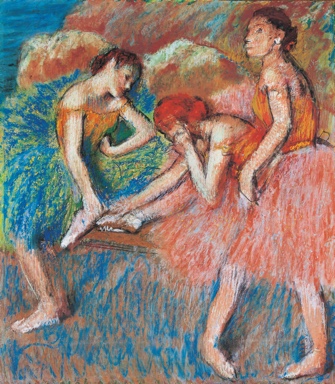
“Danseuses (Danseuses au Repos)” (c. 1898). © Lausanne, fondation de l’Hermitage/Photo: Giorgio Skory, Romanel-sur-Lausanne
freer, more expressive treatments. Some attributed this change, like that of the Impressionist master, to Degas’ failing eyesight, but Rey sees that as a reductive explanation for an artistic choice.
A bachelor and anti-Dreyfusard (hence anti-Semite), Degas was something of a crank (his quarrelsome temperament eventually drove away most of his friends, including the amiable and tolerant Auguste Renoir). With his eyesight failing, he seems to have stopped working entirely five years before his death and spent his last, lonely years wandering the streets of Paris.
In the end, for all the reasons enumerated above and also because Degas himself spurned the Impressionist label, I think we can safely say that he was not an Impressionist.
A visit to this lovely little retrospective is well worth the trip to Giverny and leaves plenty of time to explore Monet’s gardens in the same day.
Musée des Impressionnismes Giverny: 99, rue Claude Monet, Giverny. Take train from Gare Saint Lazare to Vernon, then shuttlebus (outside train station). Tel: 02 32 51 94 65. Open daily, 10am-6pm. Through July 19, 2015. Admission: €7 (combined ticket with Monet’s house and garden: €16.50). www.mdig.fr
Reader Richard Ewan writes: “Degas, as far as my studies have shown, liked to draw his figures and then move them around to work out his composition with great care. He was obsessed with the placement and how the figures looked in the picture frame. His method of working the composition would eliminate the ability to make a plein air painting because the composition is already dictated and the speed necessary to capture the view doesn’t allow for much precision.”
Reader reaction: Click here to respond to this article (your response may be published on this page and is subject to editing).
Please support Paris Update by ordering books from Paris Update’s Amazon store at no extra cost. Click on your preferred Amazon location: U.K., France, U.S.
More reviews of Paris art shows.
© 2015 Paris Update
Favorite